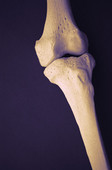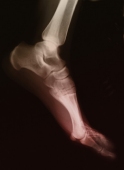| 
Scientists Discover How Osteoarthritis Destroys Cartilage

THURSDAY, Sept. 4 (HealthDay News) -- The first direct proof of how osteoarthritis destroys cartilage has been discovered by University of Rochester Medical Center researchers.
They said their finding could lead to preventive treatments for a disease that affects almost 21 million aging Americans and is the leading cause of disability in the United States.
Until now, little was known about the cellular and molecular mechanisms that cause the break down of the cartilage in joints. Previous research suggested that higher levels of signaling protein called beta-catenin were associated with osteoarthritis (OA), but there was no direct evidence to confirm that link.
The University of Rochester Medical Center team genetically engineered mice with high levels of beta-catenin and found the mice lost most of their articular cartilage -- the protective layer that covers the ends of bones within joints. The mice also developed the same bony growths and microfractures that occur in people with OA.
In a companion experiment, the researchers also found much higher-than-normal beta-catenin levels in cartilage cells taken from patients with severe arthritis.
"We have created the first model in a living animal that shows exactly how osteoarthritis causes damage. That, of course, puts us in position to interfere with the processes that contribute to the damage in a new and powerful way," study author Dr. Di Chen, an associate professor in the department of orthopedics, said in a university news release.
The study was published Sept. 2 in the Journal of Bone and Mineral Research.
"The first step was to prove that beta-catenin is central to OA development, and I think we have done that," Chen said. "Now, we are seeking to confirm that mechanical loading and meniscal injury create higher levels of beta-catenin in osteoarthritis joints, and that this and meniscal injury [the meniscus is the sponge-like layer of cartilage between the bones of the knee] create higher levels of beta-catenin in osteoarthritic joints, and that this in turn causes cartilage destruction and too fast differentiation of cartilage into bone."
More information
The Arthritis Foundation has more about osteoarthritis  . .
|  |

Bunion Surgery Patients Need 6 Weeks Before Driving

THURSDAY, Aug. 28 (HealthDay News) -- The ability to brake suddenly while driving is fully returned six weeks following bunion surgery, researchers say.
A bunion is the bump just below the big toe that can occur when the big toe begins to angle sideways toward the second toe. Bunions can become swollen and painful, sometimes making it hard to walk. In these cases, surgical treatment to realign the bone, ligaments, and tendons may be required.
Six weeks following bunion surgery, most people have low enough pain levels that they are able to drive. But until now, no studies had been done to find out if driving six weeks after bunion surgery is actually safe.
A new study in the August issue of the Journal of Bone and Joint Surgery evaluated motor skills in 28 patients who had undergone bunion surgery on the right foot.
For their study, the researchers used a custom-made driving simulator to compare total brake response time, reaction time, and actual brake time in the bunion surgery patients to a group of 28 control participants matched for age, driving status, and sex.
Two weeks after the surgery, only 25 percent of the patients were able to complete the test. But after six weeks, the patients' reaction, brake, and total brake response times were even better than they had been before the bunion was repaired and were similar to the control group.
"It is probably not advisable to drive before six weeks after bunion surgery on the right foot -- our research shows that the reflexes and the power required to brake suddenly in an emergency is fully returned only at six weeks in the post-operative period," Dr. Graeme Holt, an orthopedic surgeon at Glasgow Royal Infirmary in the United Kingdom and co-author of the study, said in an American Academy of Orthopaedic Surgeons' press release. "However, it is extremely important for all patients to discuss when they can return to driving with their surgeon after having any type of surgery to their foot."
People who drive before six weeks following their surgery are at risk of re-injuring their foot if they have to apply the emergency brake, the researchers said.
More information
The American College of Foot and Ankle Surgeons has more about bunions  . .
|  |

Splints as Good as Plaster Casts for Minor Fractures
 WEDNESDAY, April 16 (HealthDay News) -- A review of past research shows cheaper, removable splints are as safe and effective as traditional plaster casts for treating minor wrist fractures in children.
But one U.S. orthopedic expert disagrees, saying that kids may be tempted to take off the split at inappropriate times and cause further damage to themselves.
"Yes, you can treat a child's buckle fracture with a splint, but I don't," Dr. Leon Benson, spokesman for the American Academy of Orthopaedic Surgeons (AAOS), said in a prepared statement. "In my experience, a child under 10 is not going to keep a splint on, and who is going to take responsibility for that fact -- the doctor. And, given that fact, what parent wants to sit on pins and needles waiting for it to happen when a safe plaster cast insures it won't?"
Minor wrist, or buckle, fractures are common among children. They often occur when a child falls on an outstretched hand. Traditionally, physicians treat these incomplete bone fractures by covering the wrist to just below the elbow in a plaster cast for a short time, often about three weeks.
Of the 10 reviewed studies that compared plaster casting to removable splints in 827 children with wrist fractures, none reported a bone deformity in any patient. The review, conducted by British researchers, was published in the current issue of The Cochrane Library.
"There are minor, or buckle, fractures of the wrist, particularly in toddlers and preschool infants, which are currently being over-treated with a plaster cast and clinic follow-up," lead investigator Alwyn Abraham, a consultant orthopedic surgeon in pediatrics at the Leicester Royal Infirmary, said in a prepared statement. "Provided these are accurately diagnosed in an emergency department, these minor fractures can be treated with a removable splint. Removal can be done at home with no further follow-up."
Plaster casts that parents could remove at home also performed as well as traditional casts, and parents preferred these more, the researchers said. Children and parents also preferred the removable Futura-brand splint, which was less expensive and less restrictive.
Benson agreed with the reviews conclusions in theory, but not in practice.
"My experience is that the younger child's pain decreases dramatically more quickly with plaster casting than a splint, and adolescents in splints often remove them around their friends, because they find them embarrassing," said Benson, who is also an associate clinical professor of orthopedic surgery at the Northwestern University Feinberg School of Medicine. "With a plaster cast, everyone can sleep at night; nothing can make that cast fall off. Yes, having a plaster cast for a few weeks is a hassle in ways, though it is possible to cover it and bathe or shower. But for the whole child and the whole family, it is a more reasonable treatment."
Benson also said the economic implication of the findings could give parents no option that offered them peace of mind: "A review like this could be used, in the U.K. system, to force people to use cheaper splinting methods of treatment rather than have a choice for plaster-casting for their child for reasons beyond narrow measures of clinical efficacy. This would be unfortunate."
More information
Safe Kids Worldwide has safety tips to prevent childhood injuries  . .
|  |
|